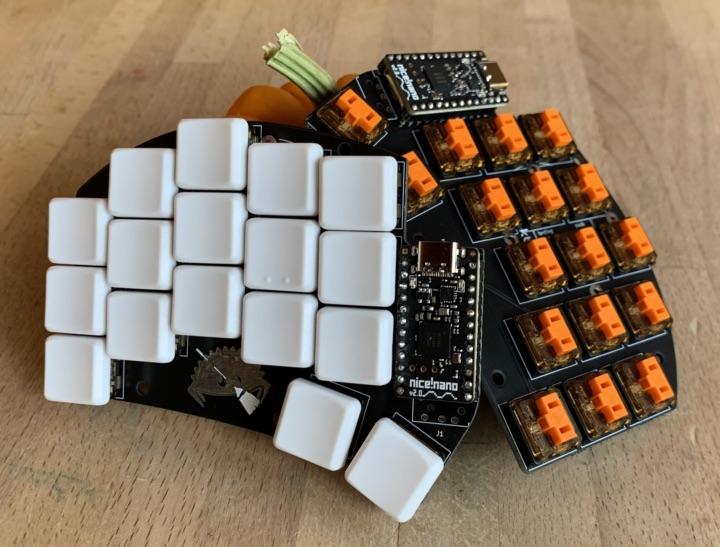Ferris Sweep
As mentioned in the last post, I’ve been happily using my Corne at home, and Manta when I go into the office, since building them. However, they present something of a false dichotomy; true split on one hand, wireless portability on the other. A couple of weeks ago, I finally got round to building a keyboard the parts for which have been sat on my shelf for a year, and that answers with the question “why not both?”.

The keyboard in question is the Ferris Sweep1, “a version of the more fabulous Ferris by Pierre Chevalier that uses a daughter board like a promicro, elite-c, bit-c, nice!nano etc. instead of using onboard components.” The idea of making a keyboard using onboard components intrigues me, but for this project the ability to add a daughter board was more important, as it allowed me to use a pair of nice!nanos. These fit the de facto standard ProMicro form factor, but pack in a more powerful microcontroller, battery charging circuitry, and wireless. One of these gives the Manta its Bluetooth chops, but it has a additional trick up its sleeve — the two halves can also use Bluetooth (specifically, BLE) to talk to each other, resulting in a fully wireless true split keyboard.
The board is also nice and simple, taking advantage that each controller only has a small number of keys to worry about (17). This allows it to avoid the need for the diodes found on most keyboards. The only things you need to solder on are the switches, the controller, and a power switch2.
The version I have is from Mechboards, where I get most of my keyboard stuff. There was some kind of mixup with their variant, meaning that it’s not completely equivalent to the standard ones. This was easily worked around with a couple of questions on their excellent support forum, and the silver lining is that it shows off the more interesting side of the nice!nanos.
In terms of switches, you can get variants of Sweep that support the de facto standard MX switches, but I decided a better fit would be Choc low profile ones. This dramatically cuts down the choices available: while there are hundreds of MX-compatible switches from dozens of manufacturers, covering every conceivable style, material and price point, there are very few Chocs beyond the (perfectly reasonable) options offered by Kalih.
The ones that caught my eye were the Sunsets, a relatively new entry manufactured by Kalih but designed by LowproKB. “The first truly new Choc switch in years” claimed to achieve a decent tactile feel despite the short travel. I’ve been enjoying the Durock Teals I used in the Manta, so I decided to give them a go. I paired them with some simple blank POM keycaps. The are nice and neat, and feel great, but more than one person has pointed out that in white they look like Rennie indigestion tablets.
The kit came with FR4 switch and bottom plates (the same material used as the base for the PCB), but I opted to skip these, soldering the switches directly to the board and leaving the bottom open. One wrinkle that I encountered with this plan was that the rubber feet that came with the kit, which need to be positioned right at the edges of the board to prevent it rocking as you type, had to overlap the pins of the switches. This meant they didn’t sit flush, and more worryingly pushed at the switches, which doesn’t seem great for long term reliability. I worked around this by replacing them with smaller feet that fit in the gaps between pins. The result, in combination with the low profile switches and keycaps, is a very svelte keyboard, around half the height of the Corne (left) and Manta (right):

So, how does it all come together? Pretty well. The portability is fantastic, and the Sunsets deliver on their promise of tactility. It took me a little while to get used to the more aggressive stagger, particularly on the outermost columns, compared to my other keyboards, but once I’d got the hang of it the overall typing experience is superb.
So, have I reached keyboard nerd Nirvana? Is this the fabled End Game? It actually might be. I’ve been using it full time both at home and the office for a couple of weeks, and it fills both roles admirably. There might be tweaks here and there, but it’s close enough to what I’m after that I may not need to make another conventional keyboard3.
Of course, that doesn’t mean I’ll not make a keyboard at all. Even leaving aside elaborate joke projects, there are plenty of interesting directions to explore — one-handed keyboards, stenographic keyboards, built in pointing devices. My immediate next project is more prosaic, however: I’m going back to the start. The RGB lighting on my Corne is broken, due to the failure of my less-than-robust bodging around my inexperienced soldering. I picked up a replacement PCB in a Mechboards sale a while ago, so will rebuild at least the left half with the benefit of more experience. After that, who knows?

ZMK firmware here.
-
Named after the mascot of the Rust programming language, who you can see on the left half. [back]
-
The one slight mishap I had in assembly was that the power switches didn’t seem to connect the batteries correctly. I’ve worked around this for now by wiring them directly to the controllers, meaning I can’t easily turn them off. ZMK has pretty good power saving, so it’s not a disaster, but a physical switch is useful to avoid the keyboards constantly waking up when jostled in a bag and running down the batteries. I plan to have another go at the switches when I have a moment. [back]
-
Yes — I’ve reached the point where I think of an unlabelled, true split, column stagger 30% keyboard as “conventional”. [back]